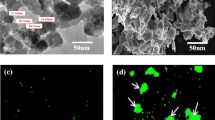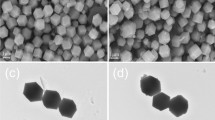Abstract
Zeolitic imidazolate frameworks (ZIF) represent one of the metal organic frameworks (MOF) with high potential for enzyme immobilization due to their exceptional chemical and thermal stability, negligible cytotoxicity, and easy synthesis under mild biocompatible conditions. Amine-functionalized ZIF-8 (An-ZIF-8) are capable of forming multipoint attachment via hydrogen bonding with lipase which will immobilize and further enhance stabilization of lipase. In addition, increased hydrophilicity of An-ZIF-8 will increase partitioning of An-ZIF-8 immobilized lipase at the aqueous/organic interface which enable lipase to expose its active site and retain its catalytic activity at its highest. Present study reports the use of ZIF-8 and An-ZIF-8 nanoparticles as carrier for Burkholderia cepacia lipase (BCL), compares the ester hydrolysis and transesterification activities of immobilized lipase with those of free lipase, and evaluates the reusability and recovery rate of the immobilized lipase. An-ZIF-8 nanoparticles (average 130.42 ± 0.55 nm) were facilely synthesized via mixing ZIF-8 nanoparticles with ammonia hydroxide solution. Despite having similar characteristics of high crystallinity and forming cuboid-like particles, An-ZIF-8 demonstrated significantly (P < 0.05) lower Brunauer-Emmett-Teller (BET) surface area and higher thermal stability than ZIF-8. BCL were successfully immobilized on ZIF-8 (BCL@ZIF-8) and An-ZIF-8 (BCL@An-ZIF-8) nanoparticles with an average lipase loading rate of ~ 8 mg/g MOF. The immobilized BCL demonstrated no significant differences in terms of esters hydrolysis and transesterification activities with those of free BCL. BCL@An-ZIF-8 demonstrated superior catalytic stability in comparison to BCL@ZIF-8 with retainment of more than 80% of its initial hydrolysis and transesterification activity for at least 10 repeated runs. In addition, more than 80% of the BCL@An-ZIF-8 can be easily recovered during each cycle of the reusability test through simple centrifugation.







Similar content being viewed by others
References
Bradford MM (1976) A rapid and sensitive method for the quantitation of microgram quantities of protein utilizing the principle of protein-dye binding. Anal Biochem 72:248–254
Chen Y, Lykourinou V, Vetromile C, Hoang T, Ming LJ, Larsen RW, Ma S (2012) How can proteins enter the interior of a MOF? Investigation of cytochrome c translocation into a MOF consisting of mesoporous cages with microporous windows. J Am Chem Soc 134:13188–13191. doi:10.1021/ja305144x
Férey G, Mellot-Draznieks C, Serre C, Millange F, Dutour J, Surblé S, Margiolaki I (2005) A chromium terephthalate-based solid with unusually large pore volumes and surface area. Science 309:2040–2042. doi:10.1126/science.1116275
Gross AF, Sherman E, Vajo JJ (2012) Aqueous room temperature synthesis of cobalt and zinc sodalite zeolitic imidizolate frameworks. Dalton Trans 41:5458–5460. doi:10.1039/C2DT30174A
He H et al (2016) Construction of thermophilic lipase-embedded metal–organic frameworks via biomimetic mineralization: a biocatalyst for ester hydrolysis and kinetic resolution. ACS Appl Mater Interfaces 8:24517–24524
Horcajada P et al (2009) Porous metal–organic-framework nanoscale carriers as a potential platform for drug delivery and imaging. Nat Mater 9:172–178. doi:10.1038/nmat2608
Huo J, Aguilera-Sigalat J, El-Hankari S, Bradshaw D (2015) Magnetic MOF microreactors for recyclable size-selective biocatalysis. Chem Sci 6:1938–1943
Jaeger K-E, Eggert T (2002) Lipases for biotechnology. Curr Opin Biotechnol 13:390–397
Kahveci D, Xu X (2011) Enhancement of activity and selectivity of Candida rugosa lipase and Candida antarctica lipase A by bioimprinting and/or immobilization for application in the selective ethanolysis of fish oil. Biotechnol Lett 33:2065–2071. doi:10.1007/s10529-011-0671-z
Liang K, Coghlan CJ, Bell SG, Doonan C, Falcaro P (2016) Enzyme encapsulation in zeolitic imidazolate frameworks: a comparison between controlled co-precipitation and biomimetic mineralisation. Chem Commun (Camb) 52:473–476. doi:10.1039/c5cc07577g
Liu W-L, Lo S-H, Singco B, Yang C-C, Huang H-Y, Lin C-H (2013a) Novel trypsin–FITC@MOF bioreactor efficiently catalyzes protein digestion. J Mater Chem B 1:928. doi:10.1039/c3tb00257h
Liu D, Wu Y, **a Q, Li Z, ** H (2013b) Experimental and molecular simulation studies of CO2 adsorption on zeolitic imidazolate frameworks: ZIF-8 and amine-modified ZIF-8. Adsorption 19:25–37. doi:10.1007/s10450-012-9407-1
Liu WL, Yang NS, Chen YT, Lirio S, Wu CY, Lin CH, Huang HY (2015) Lipase-supported metal-organic framework bioreactor catalyzes warfarin synthesis. Chem-Eur J 21:115–119
Lykourinou V et al (2011) Immobilization of MP-11 into a mesoporous metal–organic framework, MP-11@mesoMOF: a new platform for enzymatic catalysis. J Am Chem Soc 133:10382–10385. doi:10.1021/ja2038003
Ma W, Jiang Q, Yu P, Yang L, Mao L (2013) Zeolitic imidazolate framework-based electrochemical biosensor for in vivo electrochemical measurements. Anal Chem 85:7550–7557. doi:10.1021/ac401576u
Md Nordin NAH, Racha SM, Matsuura T, Misdan N, Abdullah Sani NA, Ismail AF, Mustafa A (2015) Facile modification of ZIF-8 mixed matrix membrane for CO2/CH4 separation: synthesis and preparation. RSC Adv 5:43110–43120. doi:10.1039/c5ra02230d
Mehta J, Bhardwaj N, Bhardwaj SK, Kim K-H, Deep A (2016) Recent advances in enzyme immobilization techniques: metal-organic frameworks as novel substrates. Coord Chem Rev 322:30–40. doi:10.1016/j.ccr.2016.05.007
Miralda CM, Macias EE, Zhu M, Ratnasamy P, Carreon MA (2012) Zeolitic imidazole framework-8 catalysts in the conversion of CO2 to chloropropene carbonate. ACS Catal 2:180–183. doi:10.1021/cs200638h
Moure VR, Fabrício C, Frensch G, Marques FA, Mitchell DA, Krieger N (2014) Enhancing the enantioselectivity of the lipase from Burkholderia cepacia LTEB11 towards the resolution of secondary allylic alcohols. Biocatal Agric Biotechnol 3:146–153
Park KS et al (2006a) Exceptional chemical and thermal stability of zeolitic imidazolate frameworks. Proc Natl Acad Sci 103:10186–10191. doi:10.1073/pnas.0602439103
Park KS et al (2006b) Exceptional chemical and thermal stability of zeolitic imidazolate frameworks. Proc Natl Acad Sci U S A 103:10186–10191. doi:10.1073/pnas.0602439103
Pencreac’h G, Baratti JC (2001) Comparison of hydrolytic activity in water and heptane for thirty-two commercial lipase preparations. Enzym Microb Technol 28:473–479. doi:10.1016/S0141-0229(00)00355-0
Persson M, Wehtje E, Adlercreutz P (2002) Factors governing the activity of lyophilised and immobilised lipase preparations in organic solvents. ChemBioChem 3:566–571
Pisklak TJ, Macías M, Coutinho DH, Huang RS, Balkus KJ (2006) Hybrid materials for immobilization of MP-11 catalyst. Top Catal 38:269–278. doi:10.1007/s11244-006-0025-6
Rambabu D, Verma P, Pradeep CP, Dhir A (2014) A cytochrome C encapsulated metal organic framework as a bio-material for sulfate ion recognition. J Mater Chem A 2:8628. doi:10.1039/c4ta01599a
Schmid A, Dordick JS, Hauer B, Kiener A, Wubbolts M, Witholt B (2001) Industrial biocatalysis today and tomorrow. Nature 409:258–268
Schröder F et al (2008) Ruthenium nanoparticles inside porous [Zn4O(bdc)3] by hydrogenolysis of adsorbed [Ru(cod)(cot)]: a solid-state reference system for surfactant-stabilized ruthenium colloids. J Am Chem Soc 130:6119–6130. doi:10.1021/ja078231u
Secundo F, Carrea G (2005) Mono- and disaccharides enhance the activity and enantioselectivity of Burkholderia cepacia lipase in organic solvent but do not significantly affect its conformation. Biotechnol Bioeng 92:438–446
Shi J, Wang X, Zhang S, Tang L, Jiang Z (2016) Enzyme-conjugated ZIF-8 particles as efficient and stable Pickering interfacial biocatalysts for biphasic biocatalysis. J Mater Chem B 4:2654–2661
Song J et al (2012) Enhanced catalytic activity of lipase encapsulated in PCL nanofibers. Langmuir 28:6157–6162
Tembe S, Kubal BS, Karve M, D’Souza SF (2008) Glutaraldehyde activated eggshell membrane for immobilization of tyrosinase from Amorphophallus companulatus: application in construction of electrochemical biosensor for dopamine. Anal Chim Acta 612:212–217
Wohlgemuth R (2010) Biocatalysis—key to sustainable industrial chemistry. Curr Opin Biotechnol 21:713–724
Zhang H, Wang Y (2016) Poly(vinyl alcohol)/ZIF-8-NH2 mixed matrix membranes for ethanol dehydration via pervaporation. AIChE J 62:1728–1739. doi:10.1002/aic.15140
Acknowledgements
This work was sponsored by K.C.Wong Magna Fund in Ningbo University. Ling-Zhi Cheong acknowledged funding support from Ningbo University (421401560).
Author information
Authors and Affiliations
Corresponding authors
Ethics declarations
Conflict of interest
The authors declare that they have no conflict of interest.
Rights and permissions
About this article
Cite this article
Cheong, LZ., Wei, Y., Wang, H. et al. Facile fabrication of a stable and recyclable lipase@amine-functionalized ZIF-8 nanoparticles for esters hydrolysis and transesterification. J Nanopart Res 19, 280 (2017). https://doi.org/10.1007/s11051-017-3979-3
Received:
Accepted:
Published:
DOI: https://doi.org/10.1007/s11051-017-3979-3




